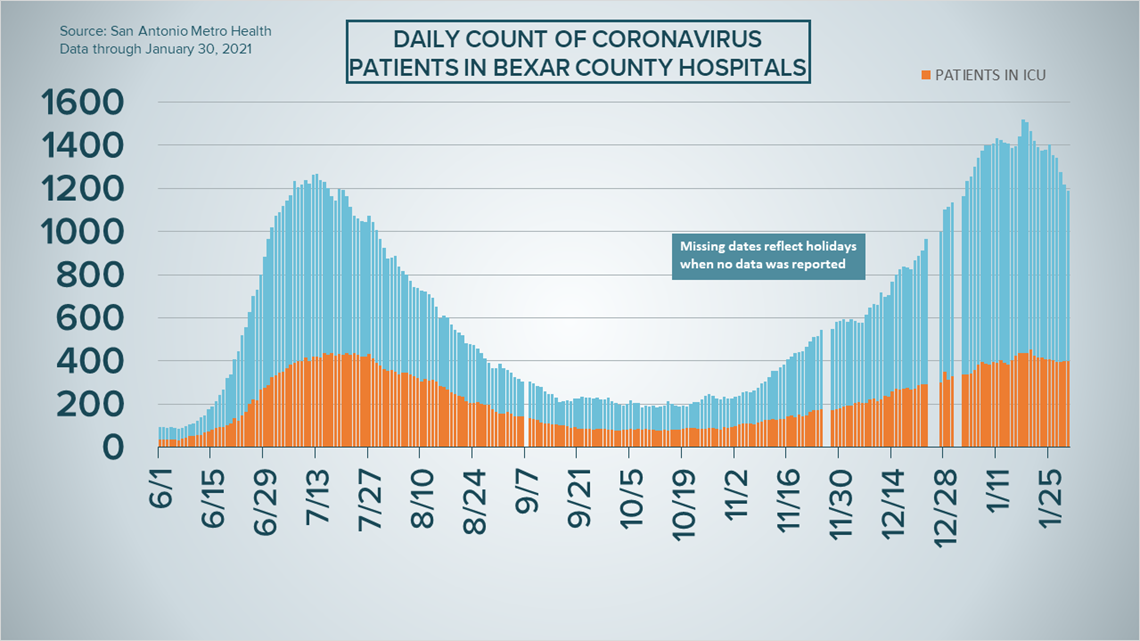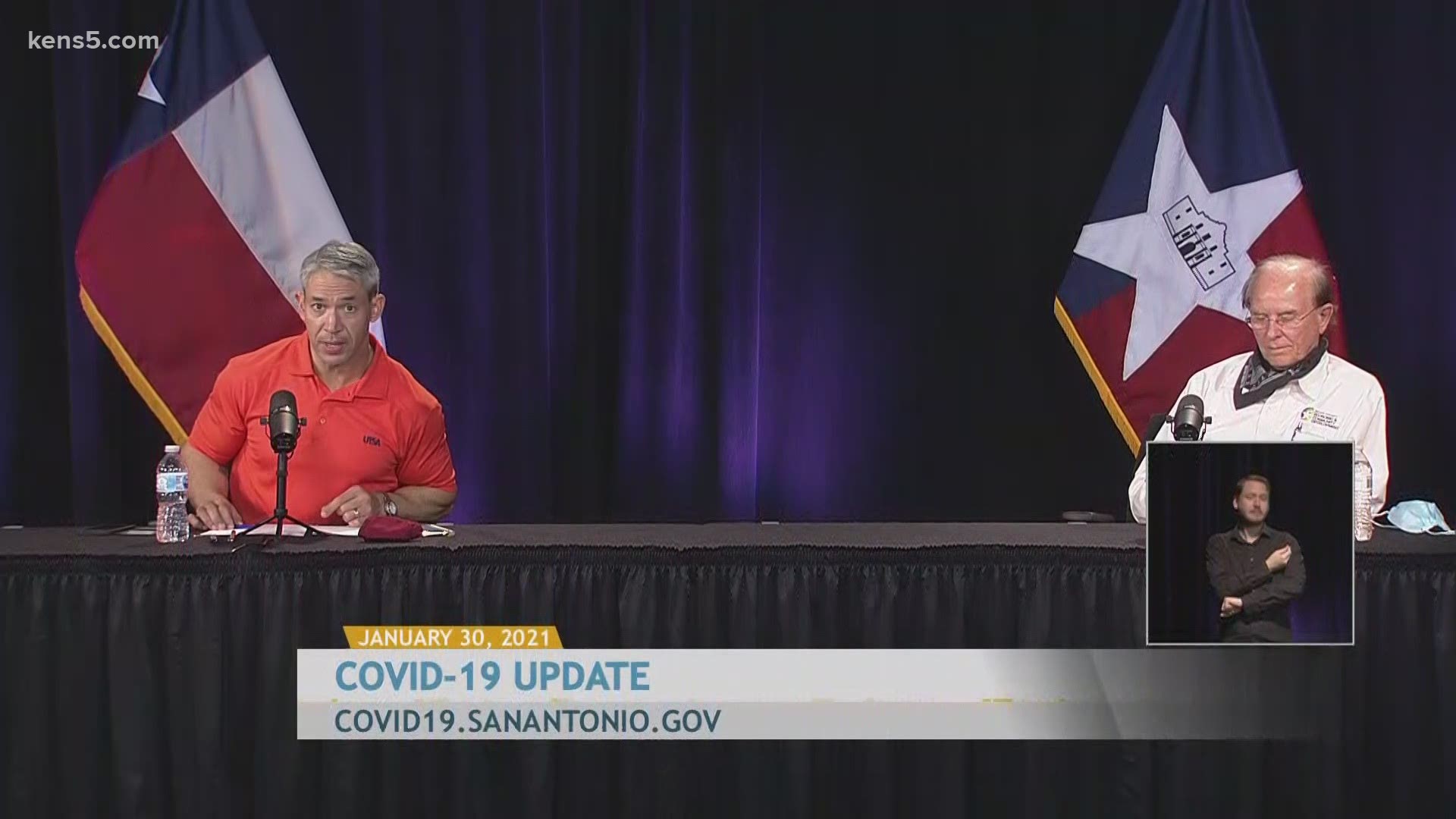SAN ANTONIO — We're tracking the latest numbers from the coronavirus pandemic in San Antonio and across Texas. Here are the latest numbers reported by Bexar and surrounding counties:
- Bexar County: On Saturday, 2,121 new cases were reported, bringing the total number of cases to 169,688. 14 new deaths were also reported, raising the local death toll to 2,060.
- Hays County: On Friday, officials reported 116 new cases in the county and one additional COVID-related fatality. As of Friday, there are a total of 14,692 lab-confirmed local cases, while the death toll rose to 186. Officials estimate 12,218 residents have recovered, while 2,288 are still ill with the virus.
- Comal County: On Friday, officials reported 88 new cases and no additional COVID-related fatalities. There are a total of 8,087 cases, including 4,302 confirmed and 3,771 probable cases, while 242 county residents have died due to COVID-19 complications. The county estimates 7,194 residents have recovered, while 651 are still ill with the virus.
More county case information is available through the Texas Department of Health Services COVID-19 dashboard.
How Bexar County is trending
We've tracked how many coronavirus cases have been confirmed in Bexar County from the time officials began reporting cases in March 2020. The graphic below shows the number of cases since June and charts those daily case numbers along a 7-day moving average to provide a more accurate picture of the overall coronavirus case curve in our area and the direction we're trending amid the pandemic.
On Saturday, San Antonio Mayor Ron Nirenberg reported an additional 2,121 new coronavirus cases in Bexar County. In all, 169,688 Bexar County residents have been diagnosed with the virus, while the seven-day moving average rose to 1,422.


Nirenberg also reported 14new coronavirus-related deaths, raising the county's death toll to 2,060 in the county since the pandemic began. In January alone, 455 Bexar County residents' deaths have been reported, making the month the second-deadliest of the pandemic. In August, 460 residents were reported to have died due to virus-related complications.
Saturday, meanwhile, saw hospitalizations continue their four-day plummet. 26 fewer coronavirus hospitalizations were reported on Saturday in comparison to Friday, bringing the day's concurrent total to 1,190. That's the lowest number of patients hospitalized due to the virus since January 2. 143 new patients were admitted in the last 24 hours.
The number of patients in intensive care fell to 398 patients, while 247 patients are on ventilators.


Coronavirus in Texas
The total number of novel coronavirus cases in the state since the pandemic began grew by 19,569 on Saturday, according to the Texas Department of State Health Services. That total includes 14,969 new confirmed cases, 3,140 new probable cases, and a backlog of 1,460. More details can be found on this page.
Saturday's figures bring the total number of Texans diagnosed with COVID-19 to more than 2.349 million.


Meanwhile, state health authorities reported another 332 deaths from coronavirus complications in Texas. In all, 36,320 Texans have died from COVID-19.
The number of COVID-19 patients receiving treatment for their symptoms throughout Texas decreased on Saturday by over 500. The concurrent total stands at 11,473.
The state estimates that about 1.933 million Texans have recovered, while 363,090 Texans remain ill with COVID-19.
The latest update from the Texas Education Agency showed that there have been at least 146,963 cumulative cases among staff and students across the state through January 24. That number comprises 93,542 positive student cases and 53,421 staff cases. More information can be found here.
The TEA releases new data on school cases on Fridays.
Latest Coronavirus Headlines
- US pauses plan to give coronavirus vaccine to Guantanamo prisoners
- CDC: Travelers required to wear masks on all public transportation
- Biden warns of growing cost of delay on $1.9T econ aid plan
- WellMed reopens reservation hotline for COVID-19 vaccine
- Coachella, Stagecoach 2021 canceled due to COVID-19
- Fauci: Vaccine makers can adjust to COVID-19 variants
Coronavirus symptoms
The symptoms of coronavirus can be similar to the flu or a bad cold. Symptoms include fever or chills, cough, shortness of breath or difficulty breathing, fatigue, muscle or body aches, headache, new loss of taste or smell sore throat, congestion or runny nose, nausea or vomiting, and diarrhea, according to the Centers for Disease Control.
Most healthy people will have mild symptoms. A study of more than 72,000 patients by the Centers for Disease Control in China showed 80 percent of the cases there were mild.
But infections can cause pneumonia, severe acute respiratory syndrome, kidney failure, and even death, according to the World Health Organization. Older people with underlying health conditions are most at risk.
Experts determined there was consistent evidence these conditions increase a person's risk, regardless of age:
- Chronic kidney disease
- COPD (chronic obstructive pulmonary disease)
- Obesity (BMI of 30 or higher)
- Immunocompromised state (weakened immune system) from solid organ transplant
- Serious heart conditions, such as heart failure, coronary artery disease, or cardiomyopathies
- Sickle cell disease
- Type 2 diabetes
The CDC believes symptoms may appear anywhere from two to 14 days after being exposed.
Human coronaviruses are usually spread...
- Between people who are in close contact with one another (within about 6 feet).
- Through respiratory droplets produced when an infected person coughs, sneezes or talks. These droplets can land in the mouths or noses of people who are nearby or possibly be inhaled into the lungs.
- Some recent studies have suggested that COVID-19 may be spread by people who are not showing symptoms.
Help stop the spread of coronavirus
- Stay home when you are sick.
- Eat and sleep separately from your family members
- Use different utensils and dishes
- Cover your cough or sneeze with your arm, not your hand.
- If you use a tissue, throw it in the trash.
Find a Testing Location
City officials recommend getting a COVID-19 test if you experience fever or chills, cough, shortness of breath or difficulty breathing, fatigue, muscle or body aches, headache, new loss of taste or smell, sore throat, congestion or runny nose, nausea or vomiting, or diarrhea.
San Antonio operates several no-cost testing locations, including two walk-up locations open Monday-Sunday from 10 a.m. until 2 p.m.:
Cuellar Community Center
5626 San Fernando St.
San Antonio, TX 78237
Ramirez Community Center
1011 Gillette Blvd.
San Antonio, TX 78224
Additionally, Freeman Coliseum offers drive-through no-cost testing from Monday through Sunday between 9 a.m. and 4 p.m. An appointment is required and can be made either online or by calling (833) 213-0643.
Here's a Testing Sites Locator to help you find the testing location closest to you in San Antonio.

